Answer these simple questions and we will find you the BEST prices
Which type of solar quotes do you need?
It only takes 30 seconds
100% free with no obligation

Get up to 4 quotes by filling in only 1 quick form

Compare quotes and find yourself the best deal

Increase the value of your home by installing solar panels
- Householdquotes.co.uk
- Solar Panels
- Solar Panel Angle & Orientation
Best Angle & Direction for Solar Panels in the UK (2025)

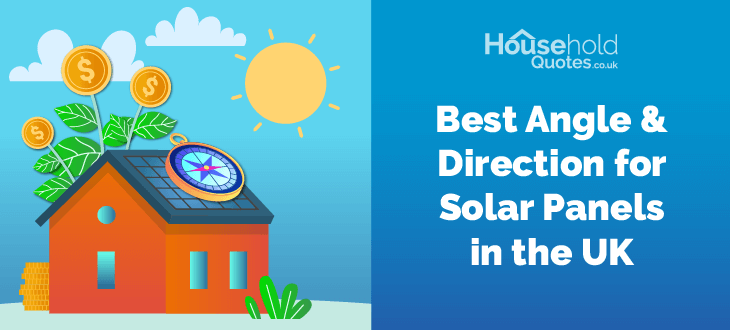
- The best angle for solar panels in the UK is between 30 and 50 degrees.
- Solar panels in the UK are the most efficient on roofs facing south or southwest.
- Factors other than angle and orientation that impede solar panels include cloud cover, air pollution, and physical obstructions.
Setting your solar panels properly is crucial to their ability to absorb sunlight. This is why not all homes are equally viable for optimal solar power, with south facing roofs with a slight westward direction and an incline of 30° to 50° being the best option. But how well do the other angles fair and are they worth the investment? Let’s discuss the optimal angles and best orientations for solar panels in the UK.
However, there are tons of other factors that go into installing solar panels which you might miss out on without professional help. That’s why getting a reliable installer is so important. The only problem is that finding one on your own can take days of complex research, contacting companies and comparing their offers. If you, like most homeowners, don’t have time for that, our service is an excellent alternative.
We can reduce your search time and provide you with up to 4 free, non-binding quotes from reputable installers in your area. We’ve vetted them to ensure the best service and competitive pricing so all you need to do is fill out a 30-second form. Click the button below to get started.
- Quotes from local installers
- Payment by finance available
- Save up to £915 per year
It only takes 30 seconds

Most optimal angle & direction for solar panels in the UK: Overview 2025
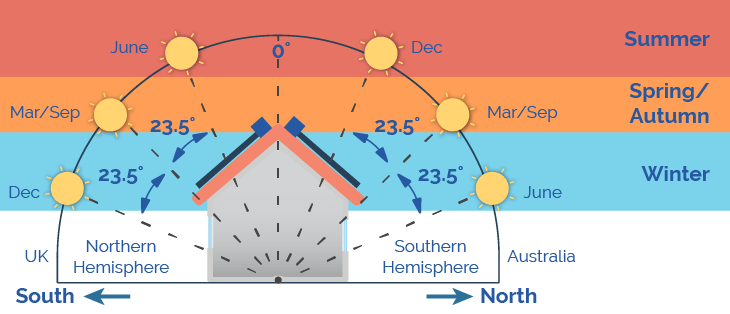
The best roof direction for solar panels in the UK is south, but with a 5 to 7 degree westward tilt. While the conventional understanding had been that the southern direction is the best overall, recent studies by the Pecan Street Research Institute imply that aiming panels very lightly to the west by just a bit can add a little more efficiency.
Since the UK resides in the Northern Hemisphere, its ideal angle is towards the equator with a southward orientation. Any other solar panel direction in the UK will be less efficient in comparison. Solar panels in Wales tend to work on the same principles, as do solar panels in Scotland.
If you don’t have an ideal solar panel roof direction, you can get a detached array for the ground or if you want to install solar panels on a flat roof. These take up a lot of space and not every might have it, but they are free for you to angle them as you please. In comparison, different types of solar panels like solar roof tiles or roof integrated solar panels provide far fewer options in angle and orientation. Despite this, modern solar panels can still work efficiently even if not at an optimal angle.
Which solar panel angle is the best for UK households?
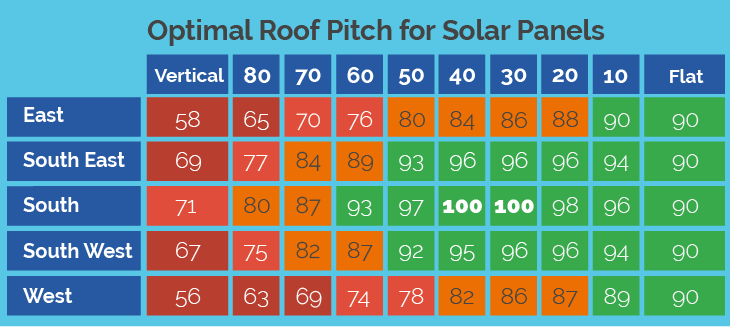
The optimum angle for solar panels in the UK resides between 30° and 50°, although the specifics can depend on your area of residence. As the sun’s position in the sky changes over time, these series of angles capture the light as well as possible over the course of months. This will lead to the least amount of variances in monthly solar panel efficiency.
Aside from the relative degrees, there are a bunch of factors you should consider when choosing the ideal angle for your panels.
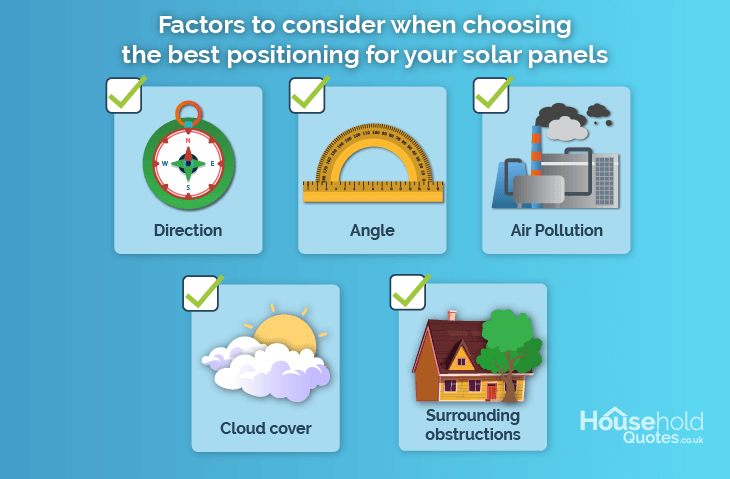
The first is the ideal sunlight angle, as discussed previously. Since the sun's position alters throughout the day, positioning your panels for maximum sunlight absorption during peak sun hours requires finding the orientation of solar panels that aligns best with the relative angle of the sun’s trajectory.
Some experts also say it’s important to adjust the tilt of the solar panels seasonally to help keep them at an optimal angle. In summer the sun is higher up, requiring a 15° lower angle. For the UK, 36.5° is ideal for summer, 66.5° is best for winter, and 40° is the average best angle year-round.
Variances in weather patterns are another factor worth considering. Events such as high humidity, increased cloud cover, and air pollution all affect the amount of sunlight you can receive. By adjusting the direction of the solar panels, it can be possible to mitigate the negative impact of environmental factors.
As always, your solar panels should be in sunlit surroundings. Tree cover, shade, and buildings are the most common culprits as they obstruct sunlight, decreasing the power solar panels can gather. They can make it necessary to alter the angle or direction of your panels to gain a better vantage point for sunlight.
That said, these factors could be just the tip of the iceberg. It’s best to get professional help to properly assess your roof and help you navigate solar panel prices in the UK. For that, you’ll need a reliable installer and finding one can be a laborious process that takes days of research. We can cut down all of those time-consuming chores so why not give our service a try instead?
We’ll provide you with up to 4 free, non-binding solar quotes within a day or two and all you have to do is fill out a 30-second form. We’ve vetted every installer, providing you with the best ones in your area so you can be sure you’re getting quality service. Click the button below to get started.
- Quotes from local installers
- Payment by finance available
- Save up to £915 per year
It only takes 30 seconds

What is the best roof direction for solar panels in the UK?
The best-angled solar panels tend to be on roofs with a south facing direction but other angles can also suffice, albeit with lower efficiency. If you’re still wondering which way should solar panels face in the UK, here are some basic breakdowns of the efficiencies for each direction and positioning of solar panels.
| Which direction should solar panels face in the UK? | |
|---|---|
| Roof angle | Efficiency |
| South | Highest |
| North | Lowest (20% to 40% less than south) |
| West | Medium (10% to 15% less than south) |
| East | Medium (10% to 15% less than south) |
North facing solar panels
North facing solar panels are quite inefficient in the UK but do well in Southern hemisphere countries like Australia. Generally, it’s not worth installing north facing solar panels in the UK. When solar panels are north facing, they turn away from the equator. This can decrease their efficiency by 20% to 40%.
East facing solar panels
Solar panels facing east can be a viable option. Southeast and southwest facing panels generate around 94% of the power a south facing array would. There is, however, a trick to it. Ordinarily, an east or west-facing roof generates around 85% of the optimal south angle but with a better incline towards the sun, this can be improved.
At lower pitches such as 30°, east or west facing panels perform better. At higher pitches, the difference between their capabilities and those of panels that face south will increase for the worse.
South facing solar panels
South is the best option that you have, especially with a light tilt of 5° to 7° westward. 30° to 50° on a south facing roof provides the best solar panel orientation in the UK. It optimises the angle and provides maximum efficiency during peak hours. It is, on average, the best position for solar panels in the UK.
But do solar panels have to face south? It may be optimal, but it’s not viable for every home in the UK. Having solar panels that face east or west may be preferable if there are too many obstructions in the southern direction.
West facing solar panels
Much like east facing panels, there are ways to make west facing solar panels in the UK work. Installing solar panels on a west facing roof can yield some benefits even if it isn’t maximising sunlight and some argue that they are better than even east facing ones. For solar panels, west facing roofs tend to provide adequate sunlight as an option, especially if they can be adjusted slightly more southward.
Overall, solar panels facing west can still be viable if a southern direction is less of an option.
Are solar panels the right choice for your home?
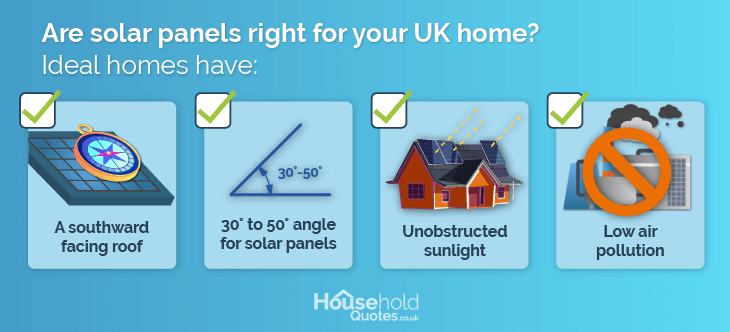
If your home allows for south facing solar panels with a pitch of 30° to 50°, you have a great starting point for solar panels. Other angles can still benefit from solar energy but not nearly as well. However, there are other factors to consider such as air pollution, tree cover, or obstructions such as other buildings.
If none of these are an issue, your home is ideal for solar energy. Most solar panels can still be useful despite one or two of these issues but you may want to rethink your installation if too many of them will be a considerable issue, as it may not be worth the investment. If you’re still wondering “are solar panels worth it for my home?”, you will have to see if the loss in efficiency matches what kilowatt (kW) system you can afford.
However, “how many solar panels do you need?” is a separate question entirely. Needless to say, that number will increase as you move away from southern and southwest directions. If you buy one facing an inadequate direction, you may need to compensate for the loss of output with a larger system.
The power output of solar panel systems in the UK is measured in kilowatts, so if you buy a 4kW system that would produce 3.8kWh when facing South, it may produce 2.5kWh to 3kWh when facing North due to the 20% to 40% loss in efficiency. The bottom line is that if you can make up for the inefficiency by buying a larger system, then you should.
You can also consider a solar battery to store any excess energy generated from your panels. This helps maximise the performance of your system, even if their angle and orientation is not ideal.
If your home seems to be fit for solar panels, the next step is finding an installer who can give you the best prices and help you navigate solar panel grants. Finding a reliable one can be quite a hassle, taking up days of searching, calling up companies, and comparing offers. So why not let us do all the heavy lifting with our handy service?
All you have to do is fill out a 30-second form and we’ll provide you with up to 4 free, non-binding quotes from reliable installers in your area. We’ve thoroughly vetted them so you can rest assured that they’re right for the job and can provide you with the best prices. Click the button below to get started.
FAQ
The optimal direction for solar panels in the UK is south. As the UK is in the Northern Hemisphere a southward direction helps face panels towards the equator.
Putting solar panels on an east facing roof in the UK is not optimal but it can still yield results. However, east facing roofs are not as good as south facing roofs.
Solar panels should ideally face the equator, so whatever direction that is relative to your home will be the best option. This can vary based on the hemisphere your country is in.
Between 30° to 50° is the optimal angle for solar panels in the UK as it provides the best yearly output on average. Aside from the angle, there are a number of other factors worth considering.

Rawal is an ex-tech journalist with a passion for sustainable innovations, green policies, and their adoption. With a straightforward writing style meant to be easily digested but full of handy tips, they are geared towards readers of all levels of familiarity with the technologies and home appliances covered.
